After experiencing so many beautiful and colourful birds in Costa Rica, Mandrew got a bit obsessed with his feathered friends. Here's a collection of his favourite bird photos from our wanderings around the Americas. Enjoy! To check out the album in Flickr, click here.
0 Comments
The highlight of my summer was definitely our incredible two week canoe trip down the Teslin and Yukon Rivers. Unlike last year’s trip, this time Chelsea and I had some company – both our dads (Doug and Jim) came along for the ride, and Chelsea’s brother Shawn & his friend Sarah joined us for the second half. As much as we enjoy each other’s company, it was a nice change to have some other people around to mix things up (and allow more options for the evening card games!). One of the best parts for me was being able to share such an awesome trip with my dad, who’s the main reason I’m into all this outdoorsy nature stuff to begin with. Thanks everyone for helping pack the trip with so many unforgettable moments! =)  the whole gang on the river the whole gang on the river Since it’s taken me such a long time to put together this post (I’ve been busy, get off my back!), I’ll skip the nitty gritty details and stick to some of the more memorable moments. If you’re interested in the practical details on the trip, I stuck those at the end. So, with no further doo-doo, I present to you "Stories from the River". Enjoy! ~ Mandrew Who needs bear spray when you’ve got Mandrew Musk™?
One morning before we’d all gotten up, Doug was lying awake in his tent when he heard something moving around beside him. He peeked out and saw a black bear sniffing about. Not wanting to alarm anyone (or the bear) he quietly watched as it made its way around our camp and over to our tent. Just as it reached us I happened to rip out a nice loud fart, startling the bear and causing it to flee for its life. Yup, I've got skills. I'd like to present our latest video, a photo-based guide sharing some advice on how to best appreciate nature. I had a lot of fun putting this one together, looking over our vast and ever-growing collection of photos from our adventures in the wild. Hope you all enjoy! - Mandrew 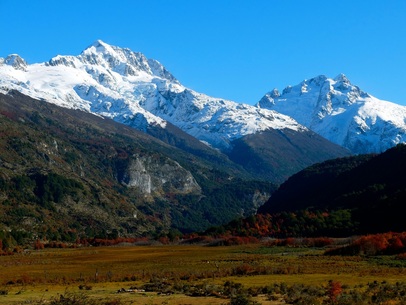 Patagonia in the Fall Patagonia in the Fall WOW - about sums it up! We just spent two weeks in Northern Patagonia (the Arctic of South America) with a rental truck. It is a weird time of year to do it since it is fall now and too cold for most tourists (but not us Canadianses) but it was great because we had the whole place to ourselves!
Ideally maybe it would have been nicer to camp with either warmer weather, or proper cold weather camping gear. We did camp a few nights but were really freezing cold (there was ice involved) so whenever possible we stayed in hostels (which were so expensive, like US$30/night compared to the rest of SA, avg US$10). The coldniss and rainyniss also made hiking slightly less enjoyable, though for the most part we had pretty good weather, considering. We started our two week truck rental in Puerto Montt (see travel map, southern Chile) and decided to also return it there since it would cost an extra US$500 to drop it off in another town, jeeeesh. We got the extra insurance to be able to cross the border into Argentina (about $100 extra) and then headed out! Our itinerary was a bit screwed up since we didn't have much success researching the best routes to take etc. So if you are reading this as a travel guide for yourself I have a number of recommendations at the bottom of this so you don't waste time like we did! 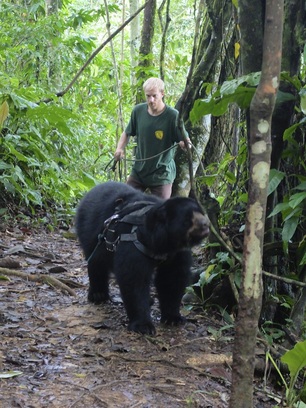 my first day on the ropes my first day on the ropes Imagine a volunteering gig where your only job is to spend your days hanging out with a couple good friends while walking a cute and cuddly dog through the Bolivian jungle. "Sounds great, sign me up!" you say? Not so fast... replace that cuddly dog with Balu, a fully-grown male Andean bear with a serious addiction to coca leaves and backpacks. Next, swap those good friends with a couple dudes you've just met, neither of which are in any way qualified to be working with a bear. Finally, factor in Balu's cunning and constant desire to catch you and engage in a very one-sided wrestling match. Still sound like fun? Glad to see that great minds think alike! Before you slip into your rubber boots and plunge headfirst into the jungle, check out the following survival tips: Check your common sense at the door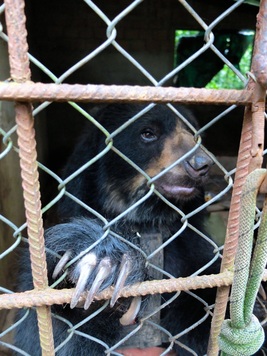 "let me out, I'm HUNGRY!" "let me out, I'm HUNGRY!" You and your two newly met teammates are about to release a three-hundred pound bear from his reinforced steel and brick enclosure with nothing but a ten meter rope and a backpack full of peanuts, fruit, and a quadruple-sealed bag of coca leaves (only to be used in SERIOUS emergencies) to keep him under control. Such a feat requires either nerves of steel or, more likely, blissful ignorance. Take things one day at a time, and keep in mind that in his eight years at Comunidad Inti Wara Yassi, a wildlife refuge in Bolivia, Balu's never injured a volunteer to the point of needing stitches (the same can’t be said for a few unlucky coca-fueled construction workers). Don't get caught Balu is quite playful, and one of his favourite games is trying to catch his volunteers (just to play, don't worry...?). He's also smarter than he looks, and will try to catch you off guard with a surprise sprint forward, a quick run back, or, on his more devious days, a surprise sprint forward followed by a quick run back (a combo which can catch even the most careful of volunteers off guard). Whether Balu's simply feeling playful or, god forbid, angry or frustrated, and despite everyone's insistence that he won't do any serious harm, you DO NOT want to get caught. Although Balu's likely to catch you at least once over the course of your month-long volunteering gig, do your best to avoid this, as it's pants-shittingly terrifying and will likely leave your favourite jungle wardrobe torn to shreds.
Some things to keep in mind in order to avoid Balu's rib-crushing bear hug: 1) Keep your distance. Although Balu can outrun you with enough motivation, he’s rather lazy and a bit overweight, and so will only try to catch you if it won't leave him out of breath. Maintain a reasonable distance and you should be safe.  How was I ever afraid of her How was I ever afraid of her My job for the month at Comunidad Inti Wara Yassi (CIWY) was to walk with Tigre (with her because she leads) in the jungle every day. Before starting my first day I was told that Tigre doesn't take trails, is very energetic, hunts and typically gets her handlers lost in the jungle overnight at least once during their stay. I was also warned how violent she can be. On the day that we arrived, the girl who was currently training to walk with Tigre was attacked pretty badly (stitches on her arms and possibly other places, I didn't really want to know more). Alarm bells started ringing in my head but something inside me told me this is something I had to do. Walking alone in the jungle with a wild cat has been a fantasy of mine for about for as long as I can remember, and only now have I realized that it is something I will really be able to do!  I wish someone had told me how gentle and patient Tigre can be, because this is the Tigre I soon got to know and love. From the moment we arrived at CIWY all I heard were horror stories about how violent she is and how other volunteers had gotten lost in the jungle overnight because of her. Still, it wasn't until I began to work with her that my subconscious fears began to surface to the point that I nearly gave up. I had imagined a much more relaxed experience. Naive, I now know.
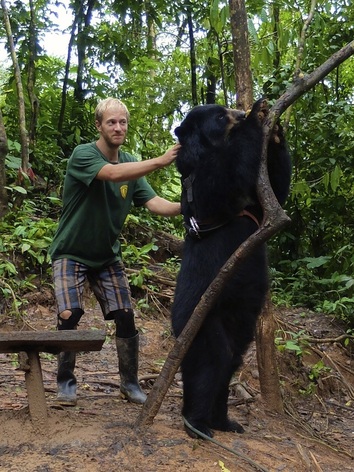 Mandrew bonding with his project, Balu Mandrew bonding with his project, Balu We first read about Comunidad Inti Wara Yassi (CIWY) in a guest book at cozy coffee shop in Copacabana about a week before we decided to go there. We were on the lookout for some sort of volunteer gig, but weren't terribly inspired by the various organic farming options we'd found online. Although it wasn't something we'd really considered, we jumped at the idea of working with jungle animals! Looking into the organization further we were touched by the story of how a Bolivian couple in the late 1980's, in the hopes of making a difference in Bolivia, established a school of alternative education outside of La Paz for the many children of miners who had relocated to the area. After being exposed to the lush surrounding rainforest and its ruthless destruction, the children vowed to protect the fragile rainforest and its animals through a campaign of education and awareness. During a later field trip to Rurrenabaque, the project took an important shift after the kids pooled together their meagre funds to purchase and rescue a spider monkey from its local owners who were forcing it to drink alcohol and dance for their amusement. Over the next few years, a number of other animals were adopted and rescued, despite the constant struggle to figure out what to do with them. Finally, Parque Machia, the first wildlife refuge in Bolivia, was established. For nearly 20 years now, professionals and volunteers from all over the world have been supporting this cause through the raising of funds and the donating of time. The organization now manages three parks in Bolivia where upwards of 500 animals of over 30 different species (including bears, cats, birds, monkeys, coatis, and foxes) are cared for.  Chelsea and Tigre chillin' in the jungle Chelsea and Tigre chillin' in the jungle A few days after reading the guest book in Copacabana we saw a poster for CIWY at our hostel in La Paz, and soon after ran into a guy who knew a guy who had volunteered with them and spent a month walking a puma. By then the seed of the idea had sprouted and taken root, and we found ourselves packing our bags. After a long day of bussing through Cochabamba and beyond, we arrived in Villa Tunari late in the evening and crawled to the closest hostel to hide from the torrential downpour that welcomed us. In the morning we walked across the bridge looking for the CIWY office, only to walk right past it. It was not marked well and looked more like an abandoned concrete structure with graffiti all over it.
We were quick to forgive the outer appearance of the office after being hailed by other volunteers watching from the cafe. On the inside, the place was humming with activity: volunteers chopping food for the monkeys, hauling hay and trees for the cats and bear, unloading endless truckloads of bananas, and disposing of bucketfuls of animal waste. Everyone looked very enthusiastic! 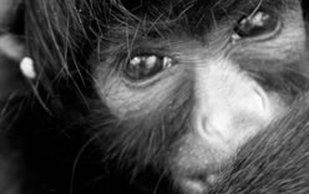 image taken from www.intiwarayassi.com image taken from www.intiwarayassi.com For the next four weeks we’ll be volunteering at a wildlife reserve called Inti Wara Yassi in the small town of Villa Tunari in Bolivia. Only in Bolivia (or another developing country, I suppose) could a place like this exist, where unqualified but willing volunteers can, after only a short lesson from other volunteers, work with and handle wild animals. We arrive partway through the workday and kill some time in the outdoor cafeteria where breakfasts, lunches, and after work beers are available. While surveying our new surroundings, we take in the graffiti from past volunteers which covers the nearby walls, including things like “Tigre the Lostalot Ocelot”, “Quaranteam 2013”, “Monkey Love”, “small (but vicious) animals”, and “Badass Balu”, and wonder what we’re about to get ourselves into.
As the workday wraps up and the volunteers straggle into the café, we strike up a conversation hoping to learn more about the volunteer experience. A couple realities quickly sink in: there will be a lot of dealing with poop, and, at some point, we’re likely to pick up a minor wound (making for an interesting scar story once we’re back at home). One of the volunteers, a skinny redhead from Australia, eagerly describes his latest encounter with a fox while working in the small animal section. While attempting to get a collar around the fox’s neck (after days in a cage, he figured it would enjoy a nice walk), the fox decided it didn’t like what was going on. After a couple quick bites to the shin (through a rubber boot), the fox clamped its jaws on the aussie’s forearm and hung on for dear life. No lasting damage was done, and we’re assured that the on-site vets are very skilled at stitching up both animals and humans. Finally, 4:30 rolls around and we’re led on a quick tour of the facilities which include: quarantine, containing about eighty capuchin monkeys, some in cages and some tied up on runners (not to mention the dozen or more wild ones that hang out hoping to snag food from the residents); the aviary, where macaws, toucans, and parrots are guarded from hungry wild monkeys by a well-trained dog; and a sizeable area for land and water turtles. We´re also told about other areas in which a number of coatis, two ocelots, one puma, and an Andean bear are kept (but which aren´t included in the express tour). We are then sat down and asked by Marta, the volunteer coordinator, to fill out a survey (along with a hefty waiver form) as well as some extra questions to help figure out which section we belong in. Chelsea’s asked if she has a good sense of direction, to which she replies yes, and I’m asked if I can handle running through the jungle with my glasses on, to which I explain that I can wear contact lenses if necessary. We’re then shown to the closet of second-hand clothing so we can pick up something we won’t mind destroying over the next weeks. Finally, we gather in the office and are given our assignments: Chelsea is to work with Tigre the Ocelot (a lucky opening since the current volunteer, just that afternoon, was jumped and received a decent scratch on her arm) and I’m to spend my first few days in quarantine, after which I’ll be working with Balu, the fully-grown Andean bear.  Something about this photo gives me the heebie-jeebies Something about this photo gives me the heebie-jeebies Shamans, medicinal plants, earthquakes, ancient cities, mysterious symbols; Peru really is the most diverse and magical country we have been to so far! Since this is our first visit to Peru (though likely not our last) we decided to go a bit more mainstream than usual and visit the recommended sites along the well-known "Gringo Trail", taking us through all of the major attractions of the country, starting with Lima. To start out on our route we headed via airplane from Iquitos to Lima, in order to save a week or more of time (the other option was another multi-day cargo boat from Iquitos since it has no road access, followed by a 24+ hour bus ride). We didn't spend much time in Lima before departing to Pisco to visit the Ballestas Islands and Paracas National Reserve, and to unexpectedly experience a 5.7 magnitude earthquake while face-timing with Donna and Jim, Andrew's parents. The next stop on the Gringo Trail was Nazca where we saw for ourselves the infamous Nazca Lines and learned a lot about the ancient cultures that inhabited the area between 100bc and 800ad, and then spent the next few days barfing due to the horrific flight over the lines and/or some bad food or water, who knows what. After Nazca was Arequipa, the second most populous city in Peru and the hub to get to the beautiful Colca Canyon (but we decided not to go there since it was a bit far and really expensive). Finally, we arrived in Cusco, our base for some intense Shamanism and of course, to visit Machu Picchu. Next and last on the list (heading out this afternoon via bus) will be the town of Puno where we can visit Lake Titicaca before crossing the border into Bolivia. We can really see why so many people travel this route: the diverse beauty and culture have taken our breath away almost every day since we have arrived. Gringo Trail - click on the icons for informationIquitos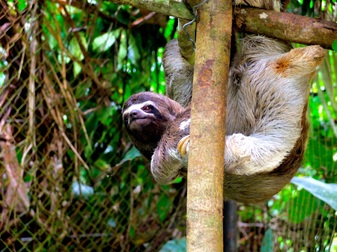 Chili sloth Chili sloth Following our insane Rio Napo trip we spent a couple of days exploring the incredibly loud Amazonian city of Iquitos. There were hardly any cars or trucks in the city, but thousands of moto-taxis (converted motorbikes with carriages on the back), thus the very noisy streets. We have come to realize, however, that almost everywhere in South and Central America so far the people seem to need noise at all hours of the day. You can't help but wonder if they purposfully design the bikes to be extra loud!
On one day while our muuuuuuch needed laundry was being done we wandered around the Belen Market, where one may find almost any kind of medicinal plant (or animal for that matter) you can think of. Of course, as is always wise while wandering in local markets, we only took out our camera a few times and made sure that not many people saw us with it, and we left anything else of any value back at the hostel. 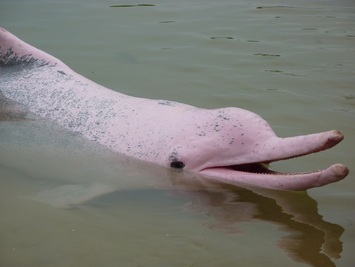 photo courtesy of electrictreehouse.com photo courtesy of electrictreehouse.com Yes they are real, and we have seen them! There is a story for the more manly in here too, don't worry. It involves criminals and crocodiles... ! During our trip along the Rio Napo from Coca to Iquitos our first stop was in a tiny town called Nuevo Rocafuerte, the place to find a local guide to take you on a trip into Yasuni National Park (without having to pay the crazy prices quoted by travel agencies in Coca). Yasuni National Park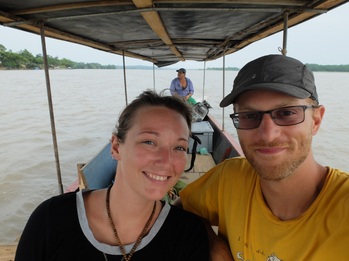 Starting our trip with Roni at the helm Starting our trip with Roni at the helm We met Roni Cox while walking around Nuevo Rocafuerte (NR) after only ten minutes. He pulled his motorcycle over to us and asked (in Spanish, of course) if we wanted a guide (himself) to Yasuni National Park. While that is exactly what we were looking for and he seemed super cool, we weren’t too quick to accept. We had been reading a few too many horror stories about people going into the jungle with fake “guides” who essentially take people down the river to their friend’s place and rob and/or murder them. I don’t think any of these stories came directly from NR, but after the weirdo motorbike robber encounter in Coca, we've been a bit more on our toes. We told him that we were actually looking for Frederico (a guide that a Park Ranger recommended to us) but we would consider his offer and come by his house later that day to let him know. We knew that there was a College in town (down the only street) that trains guides so we went there and asked if they knew Roni. They sure did and said that he was great.  admiring the sunset from our lancha admiring the sunset from our lancha Within a few hours we managed to meet a couple of solo travellers, María-José from Chile and Rodrigo from Argentina, who were also looking to go into the park and after some consideration the four of us decided to go for it! Roni turned out to be a great guide, very enthusiastic and funny. The four of us had a blast riding in the smaller lancha (boat with outboard motor) through the Yasuni River and into a large lagoon called Jatuncocha (Quecha for "large lake"). We spent 3 days and 2 nights in the park, hiking for a few hours each day, learning about the plants and birds, watching the pink river dolphins breaching in the river (SO COOL!!), and fishing for piranhas before dark. After eating dinner and playing a couple rounds of cards (ninety-nine, or noventa y nueve en Español), we took the lancha out to do some caiman watching! We really didn’t have too much chill time, always on the go and keeping watch for some rare creatures! Mandrew had a great time snapping photos of birds as we passed by - he said it was a lot like the video game "Pokemon Snap" or something ... On the last day we did end up seeing the giant river otters, which was a great bonus! 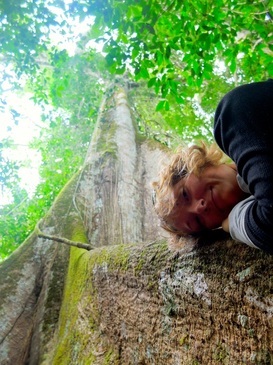 Chelsea listening to the tree spirits... Chelsea listening to the tree spirits... When we got back to NR we parted ways with María-José and Rodrigo, sadly as they were a lot of fun, and started looking into plans to get further down the river, eventually to Iquitos in Peru which we have been told can take anywhere from 3-11 days on a barca (cargo boat). We had been hearing rumours that there would be one leaving from Pantoja (the first small town on the Peruvian side of the border) on Saturday or Sunday (it was Wednesday at this point). It's always a bit hard to tell with this kind of info in these small, isolated towns - we actually thought near the end that we may have somehow started this rumour ourselves - so really weren’t too confident. At any rate, we'd had enough of NR and decided to make our way across the border and into Pantoja to try our luck. Rio Aguarico - Crocodile hunting |



 RSS Feed
RSS Feed